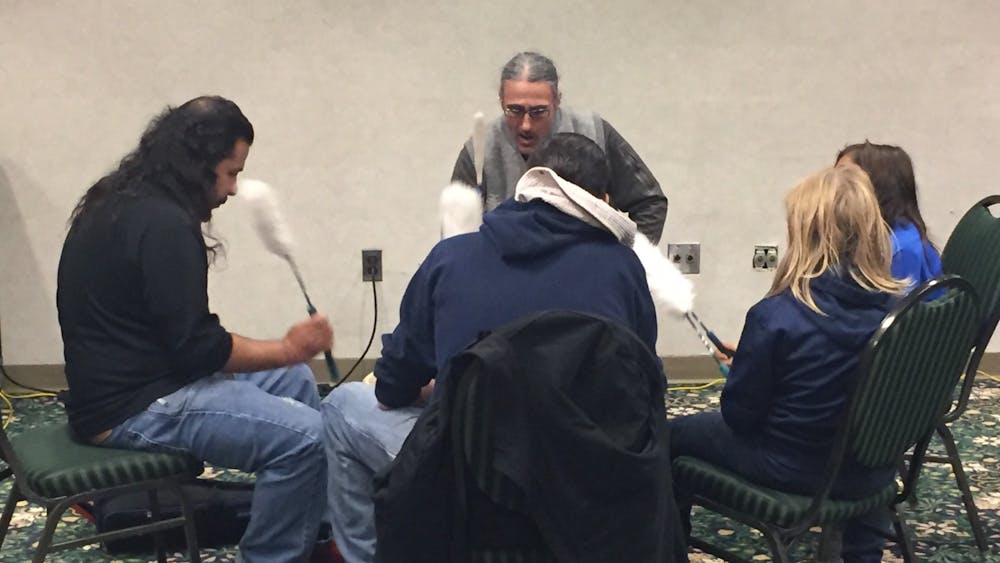The creation and production of Native American jewelry started as early as 12,000 years ago. "Paleo-Indians transformed materials like shell and stone into wearable jewelry, and tribes across America followed suit." Animal and fishbones often could be etched into beautiful and elaborate pendants. Shells, stones, and coral were "chipped into tiny beads for necklaces or clothing decorations." These jewelry pieces are still made today with materials like gold and titanium.
Students interested in learning about Two-Spirit Identity and creating beautiful pride jewelry met in the Student Center Intersection on Tuesday, Nov. 19.
Becca Lynn, creator of QueerKwe Designs, is an "Anishinaabe artist trying to create space and representation for two spirit and LGBTQ indigenous fol[k] through [her] beadwork." She partnered with EMU's Native American Student Organization (NASO) and the Center of Race & Ethnicity (CORE) to host this event.
Lynn shared what she had planned for the evening: “I’ll be giving a lecture with a brief overview of indigenous world views, traditional gender roles in our communities, and the ongoing effects of colonization.” She continued: “I want to open up a dialogue as we make our identity necklaces and bracelets out of pony beads.”
When asked what Two-Spirit Identity means, Lynn gave a very descriptive definition, as it is a very “complex [and] contemporary term.”
“It is often described as an indigenous person whose spirit is both masculine and feminine and used as an umbrella term for LGBTQ+ Identified indigenous folks," she explained. “It is a very cultural and spiritually specific term."
Lynn hopes that students learn the complexities of Two-Spirit Identity and the ways it exists outside of western ideas of gender and sexuality.
“Indigenous ways of life are very contradictory to American ways and it can be harmful to view two spirit identity through a western lens,“ she said. “I want them to see the beauty and resilience that comes with this resurgence of two spirit identity."
During the presentation, Lynn touched on how colonization negatively affected the Native Americans.
“A lot of Ashinaabe traditions and stories were lost," she explained. “We look to our elders [in the Ashinaabe community] to put this puzzle together; to see what they remember.”
When the Europeans invaded Native American territory, the first thing they noticed was how the Native Americans approached gender roles.
“Men liked to wear sparkly jewelry and hunt, while women were involved in agriculture and seemed to have more masculine qualities,“ Lynn explained. “Men were seen as meek while women were seen as strong, which is very different from Western culture.”
When it comes to Two-Spirit Identity, not every tribe is very accepting. Lynn explained that these views were most likely inherited from the Europeans that invaded their territory, as Native people used to be more accepting of Two-Spirit Identity.
“There didn’t used to be genders or gender roles," Lynn explained. “Everyone worked together to ensure the success of the tribe. Every member was valuable and important.”
As of now, Two-Spirit people have found outlets where they can feel welcome as a part of the community. Organizations like Project 562 have stepped forward to make a change for people who identify as Two-Spirit.
“[Project 562’s goal is] to help develop a body of imagery and cultural representations of Native Peoples to counteract the one-dimensional stereotypes circulating in...media, historical textbooks and the culture industry.”
After the event, Lynn hopes students to start a conversation about Two-Spirit Identity. As a member of the community herself, Lynn would like to see positive changes made.
"Learn our histories. Invite us to the table. Make sure our voices are being uplifted and valued. [Students must] understand that they need to go home and do their own critical research after this event.”
To learn more about Becca Lynn and her mission, visit her Facebook page (@queerkwedesigns). If topics like this interest you, consider attending events hosted by EMU’s Native American Student Organization (@EMUNASO) or the Center of Race & Ethnicity (@EMUCORE).












